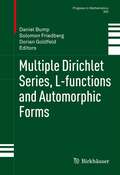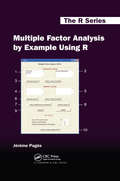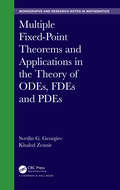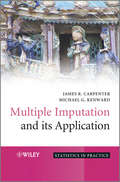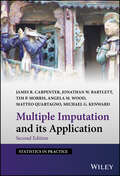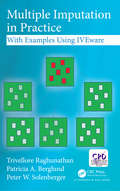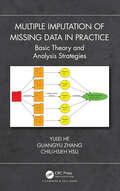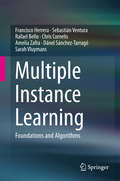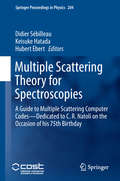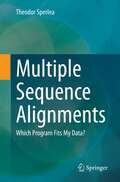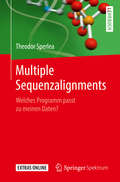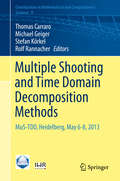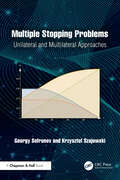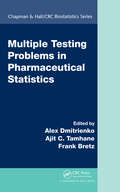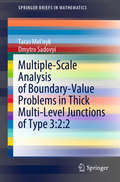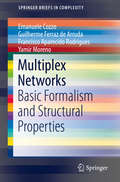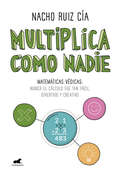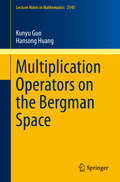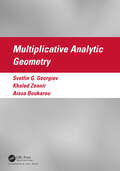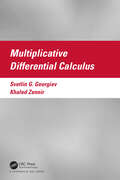- Table View
- List View
Multiple Dirichlet Series, L-functions and Automorphic Forms
by Daniel Bump Solomon Friedberg Dorian GoldfeldMultiple Dirichlet Series, L-functions and Automorphic Forms gives the latest advances in the rapidly developing subject of Multiple Dirichlet Series, an area with origins in the theory of automorphic forms that exhibits surprising and deep connections to crystal graphs and mathematical physics. As such, it represents a new way in which areas including number theory, combinatorics, statistical mechanics, and quantum groups are seen to fit together. The volume also includes papers on automorphic forms and L-functions and related number-theoretic topics. This volume will be a valuable resource for graduate students and researchers in number theory, combinatorics, representation theory, mathematical physics, and special functions. Contributors: J. Beineke, B. Brubaker, D. Bump, G. Chinta, G. Cornelissen, C.A. Diaconu, S. Frechette, S. Friedberg, P. Garrett, D. Goldfeld, P.E. Gunnells, B. Heim, J. Hundley, D. Ivanov, Y. Komori, A.V. Kontorovich, O. Lorscheid, K. Matsumoto, P.J. McNamara, S.J. Patterson, M. Suzuki, H. Tsumura.
Multiple Factor Analysis by Example Using R: Sense, Sentimentality And The Soldier-horse Relationship In The Great War (Chapman And Hall/crc The R Ser. #83)
by Jérôme PagèsMultiple factor analysis (MFA) enables users to analyze tables of individuals and variables in which the variables are structured into quantitative, qualitative, or mixed groups. Written by the co-developer of this methodology, Multiple Factor Analysis by Example Using R brings together the theoretical and methodological aspects of MFA. It also inc
Multiple Fixed-Point Theorems and Applications in the Theory of ODEs, FDEs and PDEs (Chapman & Hall/CRC Monographs and Research Notes in Mathematics)
by Svetlin G. Georgiev Khaled ZennirMultiple Fixed-Point Theorems and Applications in the Theory of ODEs, FDEs and PDEs covers all the basics of the subject of fixed-point theory and its applications with a strong focus on examples, proofs and practical problems, thus making it ideal as course material but also as a reference for self-study. Many problems in science lead to nonlinear equations T x + F x = x posed in some closed convex subset of a Banach space. In particular, ordinary, fractional, partial differential equations and integral equations can be formulated like these abstract equations. It is desirable to develop fixed-point theorems for such equations. In this book, the authors investigate the existence of multiple fixed points for some operators that are of the form T + F, where T is an expansive operator and F is a k-set contraction. This book offers the reader an overview of recent developments of multiple fixed-point theorems and their applications. About the Authors Svetlin G. Georgiev is a mathematician who has worked in various areas of mathematics. He currently focuses on harmonic analysis, functional analysis, partial differential equations, ordinary differential equations, Clifford and quaternion analysis, integral equations and dynamic calculus on time scales. Khaled Zennir is assistant professor at Qassim University, KSA. He received his PhD in mathematics in 2013 from Sidi Bel Abbès University, Algeria. He obtained his Habilitation in mathematics from Constantine University, Algeria in 2015. His research interests lie in nonlinear hyperbolic partial differential equations: global existence, blow up and long-time behavior.
Multiple Imputation and its Application
by Michael Kenward James CarpenterA practical guide to analysing partially observed data.Collecting, analysing and drawing inferences from data is central to research in the medical and social sciences. Unfortunately, it is rarely possible to collect all the intended data. The literature on inference from the resulting incomplete data is now huge, and continues to grow both as methods are developed for large and complex data structures, and as increasing computer power and suitable software enable researchers to apply these methods.This book focuses on a particular statistical method for analysing and drawing inferences from incomplete data, called Multiple Imputation (MI). MI is attractive because it is both practical and widely applicable. The authors aim is to clarify the issues raised by missing data, describing the rationale for MI, the relationship between the various imputation models and associated algorithms and its application to increasingly complex data structures.Multiple Imputation and its Application:Discusses the issues raised by the analysis of partially observed data, and the assumptions on which analyses rest.Presents a practical guide to the issues to consider when analysing incomplete data from both observational studies and randomized trials.Provides a detailed discussion of the practical use of MI with real-world examples drawn from medical and social statistics.Explores handling non-linear relationships and interactions with multiple imputation, survival analysis, multilevel multiple imputation, sensitivity analysis via multiple imputation, using non-response weights with multiple imputation and doubly robust multiple imputation.Multiple Imputation and its Application is aimed at quantitative researchers and students in the medical and social sciences with the aim of clarifying the issues raised by the analysis of incomplete data data, outlining the rationale for MI and describing how to consider and address the issues that arise in its application.
Multiple Imputation and its Application (Statistics in Practice)
by James R. Carpenter Michael G. Kenward Jonathan W. Bartlett Tim P. Morris Angela M. Wood Matteo QuartagnoMultiple Imputation and its Application The most up-to-date edition of a bestselling guide to analyzing partially observed data In this comprehensively revised Second Edition of Multiple Imputation and its Application, a team of distinguished statisticians delivers an overview of the issues raised by missing data, the rationale for multiple imputation as a solution, and the practicalities of applying it in a multitude of settings. With an accessible and carefully structured presentation aimed at quantitative researchers, Multiple Imputation and its Application is illustrated with a range of examples and offers key mathematical details. The book includes a wide range of theoretical and computer-based exercises, tested in the classroom, which are especially useful for users of R or Stata. Readers will find: A comprehensive overview of one of the most effective and popular methodologies for dealing with incomplete data sets Careful discussion of key concepts A range of examples illustrating the key ideas Practical advice on using multiple imputation Exercises and examples designed for use in the classroom and/or private study Written for applied researchers looking to use multiple imputation with confidence, and for methods researchers seeking an accessible overview of the topic, Multiple Imputation and its Application will also earn a place in the libraries of graduate students undertaking quantitative analyses.
Multiple Imputation in Practice: With Examples Using IVEware
by Trivellore Raghunathan Patricia A. Berglund Peter W. SolenbergerMultiple Imputation in Practice: With Examples Using IVEware provides practical guidance on multiple imputation analysis, from simple to complex problems using real and simulated data sets. Data sets from cross-sectional, retrospective, prospective and longitudinal studies, randomized clinical trials, complex sample surveys are used to illustrate both simple, and complex analyses. Version 0.3 of IVEware, the software developed by the University of Michigan, is used to illustrate analyses. IVEware can multiply impute missing values, analyze multiply imputed data sets, incorporate complex sample design features, and be used for other statistical analyses framed as missing data problems. IVEware can be used under Windows, Linux, and Mac, and with software packages like SAS, SPSS, Stata, and R, or as a stand-alone tool. This book will be helpful to researchers looking for guidance on the use of multiple imputation to address missing data problems, along with examples of correct analysis techniques.
Multiple Imputation of Missing Data in Practice: Basic Theory and Analysis Strategies
by Yulei He Guangyu Zhang Chiu-Hsieh HsuMultiple Imputation of Missing Data in Practice: Basic Theory and Analysis Strategies provides a comprehensive introduction to the multiple imputation approach to missing data problems that are often encountered in data analysis. Over the past 40 years or so, multiple imputation has gone through rapid development in both theories and applications. It is nowadays the most versatile, popular, and effective missing-data strategy that is used by researchers and practitioners across different fields. There is a strong need to better understand and learn about multiple imputation in the research and practical community. Accessible to a broad audience, this book explains statistical concepts of missing data problems and the associated terminology. It focuses on how to address missing data problems using multiple imputation. It describes the basic theory behind multiple imputation and many commonly-used models and methods. These ideas are illustrated by examples from a wide variety of missing data problems. Real data from studies with different designs and features (e.g., cross-sectional data, longitudinal data, complex surveys, survival data, studies subject to measurement error, etc.) are used to demonstrate the methods. In order for readers not only to know how to use the methods, but understand why multiple imputation works and how to choose appropriate methods, simulation studies are used to assess the performance of the multiple imputation methods. Example datasets and sample programming code are either included in the book or available at a github site (https://github.com/he-zhang-hsu/multiple_imputation_book). Key Features Provides an overview of statistical concepts that are useful for better understanding missing data problems and multiple imputation analysis Provides a detailed discussion on multiple imputation models and methods targeted to different types of missing data problems (e.g., univariate and multivariate missing data problems, missing data in survival analysis, longitudinal data, complex surveys, etc.) Explores measurement error problems with multiple imputation Discusses analysis strategies for multiple imputation diagnostics Discusses data production issues when the goal of multiple imputation is to release datasets for public use, as done by organizations that process and manage large-scale surveys with nonresponse problems For some examples, illustrative datasets and sample programming code from popular statistical packages (e.g., SAS, R, WinBUGS) are included in the book. For others, they are available at a github site (https://github.com/he-zhang-hsu/multiple_imputation_book)
Multiple Instance Learning
by Sebastián Ventura Francisco Herrera Rafael Bello Chris Cornelis Amelia Zafra Dánel Sánchez-Tarragó Sarah VluymansThis book provides a general overview of multiple instance learning (MIL), defining the framework and covering the central paradigms. The authors discuss the most important algorithms for MIL such as classification, regression and clustering. With a focus on classification, a taxonomy is set and the most relevant proposals are specified. Efficient algorithms are developed to discover relevant information when working with uncertainty. Key representative applications are included. This book carries out a study of the key related fields of distance metrics and alternative hypothesis. Chapters examine new and developing aspects of MIL such as data reduction for multi-instance problems and imbalanced MIL data. Class imbalance for multi-instance problems is defined at the bag level, a type of representation that utilizes ambiguity due to the fact that bag labels are available, but the labels of the individual instances are not defined. Additionally, multiple instance multiple label learning is explored. This learning framework introduces flexibility and ambiguity in the object representation providing a natural formulation for representing complicated objects. Thus, an object is represented by a bag of instances and is allowed to have associated multiple class labels simultaneously. This book is suitable for developers and engineers working to apply MIL techniques to solve a variety of real-world problems. It is also useful for researchers or students seeking a thorough overview of MIL literature, methods, and tools.
Multiple Perspectives on Difficulties in Learning Literacy and Numeracy
by Claire Wyatt-Smith Stephanie Gunn John ElkinsThere are many approaches to researching the difficulties in learning that students experience in the key areas of literacy and numeracy. This book seeks to advance understanding of these difficulties and the interventions that have been used to improve outcomes. The book addresses the sometimes complementary and sometimes contradictory results, and generates new approaches to understanding and serving students with difficulties in literacy and numeracy. The book represents a departure from conventional wisdom as most scholars and graduate students draw upon ideas from only one of the three domains focal in the book and usually from one single or dominant theoretical frame. Typically, readers will affiliate with reading education, mathematics education, or learning disabilities and belong to one of the corresponding professional associations such as IRA, NCTM, or CLD. This book's scope will open a scholarly forum for engaging readers with a familiarity with one of these domains while providing insight into the others on offer in the book.
Multiple Regression: A Practical Introduction
by John M. Roberts Aki RobertsMultiple Regression: A Practical Introduction is a text for an advanced undergraduate or beginning graduate course in statistics for social science and related fields. Also, students preparing for more advanced courses can self-study the text to refresh and solidify their statistical background. Drawing on decades of teaching this material, the authors present the ideas in an approachable and nontechnical manner, with no expectation that readers have more than a standard introductory statistics course as background. Multiple regression asks how a dependent variable is related to, or predicted by, a set of independent variables. The book includes many interesting example analyses and interpretations, along with exercises. Each dataset used for the examples and exercises is small enough for readers to easily grasp the entire dataset and its analysis with respect to the specific statistical techniques covered. SPSS, Stata, SAS, and R code and commands for each type of analysis or recoding of variables in the book are available on an accompanying website, along with solutions to the exercises (on the instructor site).
Multiple Regression: A Practical Introduction
by John M. Roberts Aki RobertsMultiple Regression: A Practical Introduction is a text for an advanced undergraduate or beginning graduate course in statistics for social science and related fields. Also, students preparing for more advanced courses can self-study the text to refresh and solidify their statistical background. Drawing on decades of teaching this material, the authors present the ideas in an approachable and nontechnical manner, with no expectation that readers have more than a standard introductory statistics course as background. Multiple regression asks how a dependent variable is related to, or predicted by, a set of independent variables. The book includes many interesting example analyses and interpretations, along with exercises. Each dataset used for the examples and exercises is small enough for readers to easily grasp the entire dataset and its analysis with respect to the specific statistical techniques covered. SPSS, Stata, SAS, and R code and commands for each type of analysis or recoding of variables in the book are available on an accompanying website, along with solutions to the exercises (on the instructor site).
Multiple Scattering Theory for Spectroscopies: A Guide To Multiple Scattering Computer Codes -- Dedicated To C. R. Natoli On The Occasion Of His 75th Birthday (Springer Proceedings In Physics #204)
by Didier Sébilleau Keisuke Hatada Hubert EbertThis edited book, based on material presented at the EU Spec Training School on Multiple Scattering Codes and the following MSNano Conference, is divided into two distinct parts. The first part, subtitled “basic knowledge”, provides the basics of the multiple scattering description in spectroscopies, enabling readers to understand the physics behind the various multiple scattering codes available for modelling spectroscopies. The second part, “extended knowledge”, presents “state- of-the-art” short chapters on specific subjects associated with improving of the actual description of spectroscopies within the multiple scattering formalism, such as inelastic processes, or precise examples of modelling.
Multiple Sequence Alignments: Which Program Fits My Data?
by Theodor SperleaThis book is a practical guide for biologists who use multiple sequence alignments (MSAs) for their data analysis and are looking for a comprehensive overview of the many different programs. Despite their important role in data analysis, there is uncertainty among researchers about exactly how MSA programs work - not to mention how and why the different analyzes lead to different results. Which program is the right one for evaluating my data and how can I ensure that I have drawn all relevant findings from the alignments? This book offers helpful explanations and background information without requiring extensive bioinformatics knowledge and slowly introduces the reader to the topic.In the first part of the book, the possible fields of application as well as the formats that are usually produced by MSA programs are described in detail. The central algorithms as well as the internal processes of the most common MSA programs of the past and the present are also explained in an uncomplicated manner in greater detail. The second part of the book is a detailed, data-based comparison between MSA programs, which is intended to help you decide which program to use for your next alignment.
Multiple Sequenzalignments: Welches Programm passt zu meinen Daten?
by Theodor SperleaDieses Buch ist ein praktischer Ratgeber für Biologinnen und Biologen, die Multiple Sequenzalignments (MSAs) für ihre Datenanalysen verwenden und einen verständlichen Überblick über die vielen verschiedenen Programme suchen. Trotz ihres wichtigen Stellenwertes in der Datenanalyse herrscht Unsicherheit unter den Forschenden wie MSA-Programme genau funktionieren - ganz zu schweigen davon, wie und warum die unterschiedlichen Analysen zu verschiedenen Ergebnissen führen. Welches Programm ist für die Auswertung meiner Daten das richtige und wie kann ich sicherstellen, alle relevanten Erkenntnisse aus den Alignments gezogen zu haben? Dieses Buch bietet hilfreiche Erklärungen und Hintergründe ohne große bioinformatische Vorkenntnisse vorauszusetzen und führt die Leserinnen und Leser langsam in die Thematik ein.Im ersten Teil des Buches werden die möglichen Einsatzfelder wie auch die Formate, die üblicherweise von MSA-Programmen produziert werden, im Detail beschrieben. Ebenso werden auf unkomplizierte Weise die zentralen Algorithmen sowie die inneren Abläufe der gängigsten MSA-Programme der Vergangenheit und der Gegenwart in größerer Detailtiefe erklärt. Den zweiten Teil des Buches bildet ein ausführlicher datenbasierter Vergleich zwischen MSA-Programmen, der als Entscheidungshilfe für die Programmauswahl für dein nächstes Alignment dienen soll.
Multiple Shooting and Time Domain Decomposition Methods
by Rolf Rannacher Stefan Körkel Thomas Carraro Michael GeigerThis book offers a comprehensive collection of the most advanced numerical techniques for the efficient and effective solution of simulation and optimization problems governed by systems of time-dependent differential equations. The contributions present various approaches to time domain decomposition, focusing on multiple shooting and parareal algorithms. The range of topics covers theoretical analysis of the methods, as well as their algorithmic formulation and guidelines for practical implementation. Selected examples show that the discussed approaches are mandatory for the solution of challenging practical problems. The practicability and efficiency of the presented methods is illustrated by several case studies from fluid dynamics, data compression, image processing and computational biology, giving rise to possible new research topics. This volume, resulting from the workshop Multiple Shooting and Time Domain Decomposition Methods, held in Heidelberg in May 2013, will be of great interest to applied mathematicians, computer scientists and all scientists using mathematical methods.
Multiple Stopping Problems: Uni- and Multilateral Approaches
by Krzysztof Szajowski Georgy SofronovThis book presents the theory of rational decisions involving the selection of stopping times in observed discrete-time stochastic processes, both by single and multiple decision-makers. Readers will become acquainted with the models, strategies, and applications of these models.It begins with an examination of selected models framed as stochastic optimization challenges, emphasizing the critical role of optimal stopping times in sequential statistical procedures. The authors go on to explore models featuring multiple stopping and shares on leading applications, particularly focusing on change point detection, selection problems, and the nuances of behavioral ecology. In the following chapters, an array of perspectives on model strategies is presented, elucidating their interpretation and the methodologies underpinning their genesis. Essential notations and definitions are introduced, examining general theorems about solution existence and structure, with an intricate analysis of optimal stopping predicaments and addressing crucial multilateral models. The reader is presented with the practical application of models based on multiple stopping within stochastic processes. The coverage includes a diverse array of domains, including sequential statistics, finance, economics, and the broader generalization of the best-choice problem. Additionally, it delves into numerical and asymptotic solutions, offering a comprehensive exploration of optimal stopping quandaries.The book will be of interest to researchers and practitioners in fields such as economics, finance, and engineering. It could also be used by graduate students doing a research degree in insurance, economics or business analytics or an advanced undergraduate course in mathematical sciences.
Multiple Testing Problems in Pharmaceutical Statistics (Chapman & Hall/CRC Biostatistics Series)
by Ajit C. Tamhane Alex Dmitrienko Frank BretzUseful Statistical Approaches for Addressing Multiplicity IssuesIncludes practical examples from recent trials Bringing together leading statisticians, scientists, and clinicians from the pharmaceutical industry, academia, and regulatory agencies, Multiple Testing Problems in Pharmaceutical Statistics explores the rapidly growing area of multiple c
Multiple Time Scale Dynamics
by Christian KuehnThis book provides an introduction to dynamical systems with multiple time scales. The approach it takes is to provide an overview of key areas, particularly topics that are less available in the introductory form. The broad range of topics included makes it accessible for students and researchers new to the field to gain a quick and thorough overview. The first of its kind, this book merges a wide variety of different mathematical techniques into a more unified framework. The book is highly illustrated with many examples and exercises and an extensive bibliography. The target audience of this book are senior undergraduates, graduate students as well as researchers interested in using the multiple time scale dynamics theory in nonlinear science, either from a theoretical or a mathematical modeling perspective.
Multiple View Geometry in Computer Vision
by Richard Hartley Andrew ZissermanA basic problem in computer vision is to understand the structure of a real world scene given several images of it. Techniques for solving this problem are taken from projective geometry and photogrammetry. Here, the authors cover the geometric principles and their algebraic representation in terms of camera projection matrices, the fundamental matrix and the trifocal tensor. The theory and methods of computation of these entities are discussed with real examples, as is their use in the reconstruction of scenes from multiple images. The new edition features an extended introduction covering the key ideas in the book (which itself has been updated with additional examples and appendices) and significant new results which have appeared since the first edition. Comprehensive background material is provided, so readers familiar with linear algebra and basic numerical methods can understand the projective geometry and estimation algorithms presented, and implement the algorithms directly from the book.
Multiple-Scale Analysis of Boundary-Value Problems in Thick Multi-Level Junctions of Type 3:2:2 (SpringerBriefs in Mathematics)
by Dmytro Sadovyi Taras Mel'nykThis book presents asymptotic methods for boundary-value problems (linear and semilinear, elliptic and parabolic) in so-called thick multi-level junctions. These complicated structures appear in a large variety of applications.A concise and readable introduction to the topic, the book provides a full review of the literature as well as a presentation of results of the authors, including the homogenization of boundary-value problems in thick multi-level junctions with non-Lipschitz boundaries, and the construction of approximations for solutions to semilinear problems. Including end-of-chapter conclusions discussing the results and their physical interpretations, this book will be of interest to researchers and graduate students in asymptotic analysis and applied mathematics as well as to physicists, chemists and engineers interested in processes such as heat and mass transfer.
Multiplex Networks: Basic Formalism and Structural Properties (SpringerBriefs in Complexity)
by Emanuele Cozzo Guilherme Ferraz de Arruda Francisco Aparecido Rodrigues Yamir MorenoThis book provides the basis of a formal language and explores its possibilities in the characterization of multiplex networks. Armed with the formalism developed, the authors define structural metrics for multiplex networks. A methodology to generalize monoplex structural metrics to multiplex networks is also presented so that the reader will be able to generalize other metrics of interest in a systematic way. Therefore, this book will serve as a guide for the theoretical development of new multiplex metrics. Furthermore, this Brief describes the spectral properties of these networks in relation to concepts from algebraic graph theory and the theory of matrix polynomials. The text is rounded off by analyzing the different structural transitions present in multiplex systems as well as by a brief overview of some representative dynamical processes. Multiplex Networks will appeal to students, researchers, and professionals within the fields of network science, graph theory, and data science.
Multiplica como nadie: Matemáticas védicas: nunca el cálculo fue tan fácil, divertido y creativo
by Nacho Ruiz¿Difíciles? ¿Aburridas? Eso se acabó. Multiplica como nadie es el primer libro en castellano que introduce las matemáticas védicas de la antigua India, un método que convierte el cálculo en algo fácil, divertido y creativo. El autor, Nacho Ruiz Cía, es el máximo exponente del movimiento por la difusión de las matemáticas védicas en España. Su misión es dar a conocer la sencillez del método, formar a padres, profesores y alumnos para que disfruten con el cálculo, desarrollen su potencial, memoria, atención y creatividad, y acabar por fin con la tan común aversión a las matemáticas. En este libro ofrece una primera aproximación a las matemáticas védicas aplicadas a la multiplicación.
Multiplication Operators on the Bergman Space
by Kunyu Guo Hansong HuangThis book deals with various aspects of commutants and reducing subspaces of multiplication operators on the Bergman space, along with relevant von Neumann algebras generated by these operators, which have been the focus of considerable attention from the authors and other experts in recent years. The book reviews past developments and offers insights into cutting-edge developments in the study of multiplication operators. It also provides commentary and comparisons to stimulate research in this area.
Multiplicative Analytic Geometry
by Svetlin G. Georgiev Khaled Zennir Aissa BoukarouThis book is devoted to multiplicative analytic geometry. The book reflects recent investigations into the topic. The reader can use the main formulae for investigations of multiplicative differential equations, multiplicative integral equations and multiplicative geometry. The authors summarize the most recent contributions in this area. The goal of the authors is to bring the most recent research on the topic to capable senior undergraduate students, beginning graduate students of engineering and science and researchers in a form to advance further study. The book contains eight chapters. The chapters in the book are pedagogically organized. Each chapter concludes with a section with practical problems. Two operations, differentiation and integration, are basic in calculus and analysis. In fact, they are the infinitesimal versions of the subtraction and addition operations on numbers, respectively. In the period from 1967 till 1970, Michael Grossman and Robert Katz gave definitions of a new kind of derivative and integral, moving the roles of subtraction and addition to division and multiplication, and thus established a new calculus, called multiplicative calculus. Multiplicative calculus can especially be useful as a mathematical tool for economics and finance. Multiplicative Analytic Geometry builds upon multiplicative calculus and advances the theory to the topics of analytic and differential geometry.
Multiplicative Differential Calculus
by Svetlin G. Georgiev Khaled ZennirThis book is devoted to the multiplicative differential calculus. Its seven pedagogically organized chapters summarize the most recent contributions in this area, concluding with a section of practical problems to be assigned or for self-study. Two operations, differentiation and integration, are basic in calculus and analysis. In fact, they are the infinitesimal versions of the subtraction and addition operations on numbers, respectively. From 1967 till 1970, Michael Grossman and Robert Katz gave definitions of a new kind of derivative and integral, moving the roles of subtraction and addition to division and multiplication, and thus established a new calculus, called multiplicative calculus. It is also called an alternative or non-Newtonian calculus. Multiplicative calculus can especially be useful as a mathematical tool for economics, finance, biology, and engineering. Multiplicative Differential Calculus is written to be of interest to a wide audience of specialists such as mathematicians, physicists, engineers, and biologists. It is primarily a textbook at the senior undergraduate and beginning graduate level and may be used for a course on differential calculus. It is also for students studying engineering and science. Authors Svetlin G. Georgiev is a mathematician who has worked in various areas of the study. He currently focuses on harmonic analysis, functional analysis, partial differential equations, ordinary differential equations, Clifford and quaternion analysis, integral equations, and dynamic calculus on time scales. He is also the author of Dynamic Geometry of Time Scales (CRC Press). He is a co-author of Conformable Dynamic Equations on Time Scales, with Douglas R. Anderson (CRC Press). Khaled Zennir earned his PhD in mathematics from Sidi Bel Abbès University, Algeria. He earned his highest diploma in Habilitation in Mathematics from Constantine University, Algeria. He is currently Assistant Professor at Qassim University in the Kingdom of Saudi Arabia. His research interests lie in the subjects of nonlinear hyperbolic partial differential equations: global existence, blowup, and long-time behavior. The authors have also published: Multiple Fixed-Point Theorems and Applications in the Theory of ODEs, FDEs and PDE; Boundary Value Problems on Time Scales, Volume 1 and Volume II, all with CRC Press.
